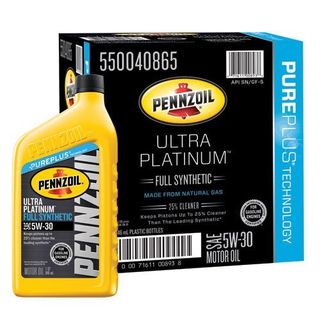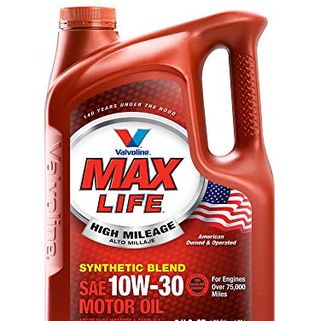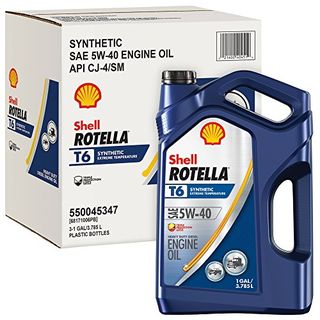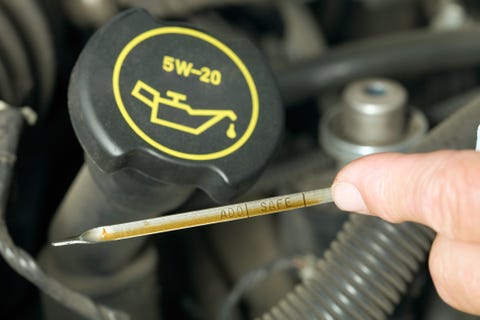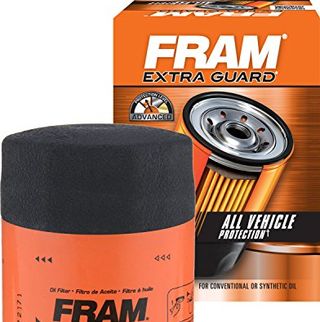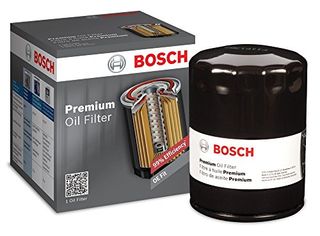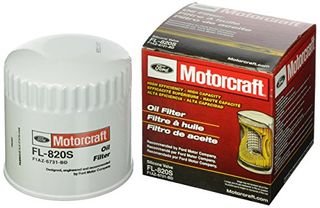Given all the options for motor oil options out there, choosing the correct oil for your automobile might seem similar a daunting task. While there is a mountain of information about the various oil choices, the commencement step is honestly quite unproblematic: Look in your car's manual.
The owner's transmission for your car will list its recommended oil weight, whether that's a standard format like 10W-30 or something more unusual. That number refers to the viscosity (or thickness) of the oil that you should use. You should accommodate which weight and blazon for the seasons and your expected use of the machine, which we'll explicate beneath. For regular use in moderate temperatures, what's listed in your owner'south transmission is fine. E'er cull an oil from a make that displays the starburst symbol that indicates the oil has been tested by the American Petroleum Institute (API).
Y'all'll likewise observe a two-character service designation on the container. API's latest service standards are SP for gasoline engines and CK-four for diesels. These letters are based on a group of laboratory and engine tests that determine the oil's power to protect the engine from clothing and high-temperature deposits and sludge. API has a full list of these standards hither in case y'all're curious, but make certain you're ownership an oil that's been tested under a current standard. Equally of this writing, that includes SP, SN, SM, SL and SJ for gasoline engines and CK-4, CJ-4, CI-4, CH-4 and FA-iv for diesels.
Those are the basics, only there's a whole lot more to the story than that.
Empathize the Labels
These are the labels you'll detect on every container of reputable motor oil. The API doughnut on the right tells you lot if the oil meets a electric current service rating. Information technology also provides the SAE (Society of Automotive Engineers) viscosity number and tells you if the oil has passed the Resource Conserving test. The starburst symbol on the left indicates that the oil has passed the service tests listed in the other doughnut.
Viscosity
Viscosity refers to a fluid's resistance to menses. About motor oils' viscosity is rated based on how thick information technology is at zero degrees Fahrenheit (represented by the number preceding the Westward, which stands winter, besides every bit its thickness at 212 degrees (represented by the second number after the dash in the viscosity designation).
Motor oil becomes thinner and runnier as it heats up and thickens every bit information technology cools. Within reason, thicker oil mostly maintains a better picture of lubrication betwixt moving parts and seals vital components of your engine better. With the correct additives to help it resist thinning too much in the oestrus, an oil can exist rated for one viscosity when cold and another viscosity when hot. The more resistant oil is to thinning, the higher the second number (10W-forty versus 10W-30, for example) volition be, and that's adept.
Meanwhile, in low temperatures, oil has to exist resistant to excessive thickening then it tin still flow properly to all the moving parts in your engine. Excessive thickness can make it more than difficult to kickoff the engine, which reduces fuel economy. If the oil is too thick, the engine requires more energy to plow the crankshaft, which is partly submerged in a bath of oil. A lower number is better earlier the Due west for cold-weather performance, so a 5W oil is typically what'southward recommended for winter utilize. Nonetheless, synthetic oils tin be formulated to flow even more easily when cold, then they are able to pass tests that meet the 0W rating.
One time the engine is running, the oil heats upward, which is why a higher 2d number is especially of import for farthermost uses and hotter-running, more than complicated engines.
Why So Many Oils?
Expect in auto parts stores and you'll run across oils labeled for all kinds of specific purposes: loftier-tech engines, new cars, higher-mileage vehicles, heavy-duty/off-road SUVs, and even cars from certain countries. You'll encounter a wide selection of viscosities.
If you read your owner'southward transmission, you'll know what oil the vehicle's manufacturer recommended to use when it was brand-new. The manual may include a reference to Energy Conserving or Resources Conserving oils, which means that the oil passed a fuel economy lab examination against a reference oil. While that doesn't e'er translate to better fuel economy, most leading brands take at least some viscosities that are labeled as such.
How to Cull Betwixt Synthetic and Conventional Motor Oil
Premium Conventional Oil: This is the standard new-car oil. All leading brands have these oils, which are available in several viscosities and tested under the latest API service level. Automakers normally specify a 5W-20 or 5W-thirty oil for colder temperatures, with a 10W-30 oil every bit optional for higher ambient temperatures. These iii ratings cover most light-duty vehicles on the route. Even more than important, though, is irresolute the oil and filter regularly. We recommend irresolute your oil every 4,000 miles or four months. The absolute minimum is twice a yr. If your car has an electronic oil-change indicator on its instrument cluster, follow its guidance instead and be sure to reset it once your oil change is done.
Full Synthetic Oil: Oils made for loftier-tech engines or heavy-duty uses, be it a Ford F-150 that tows frequently or a Chevrolet Corvette with the latest supercharged LS engine, are full of synthetic additives. These oils' labels indicate whether they've passed stringent special tests for superior, longer-lasting functioning in all the critical areas, from viscosity index to protection against deposits. They flow ameliorate at low temperatures and maintain tiptop viscosity at loftier temperatures. So, why shouldn't everyone use them? These oils are expensive and not every engine needs them. At that place may fifty-fifty be some features that your engine needs that synthetic oils don't take. Again, follow the guidance in your owner's manual.
Synthetic Alloy Oil: These have a dose of synthetic oil mixed with organic oil, and are formulated to provide protection for somewhat heavier engine loads and loftier temperatures. This generally ways they're less volatile, so they evaporate far less, which reduces oil loss and increases fuel economic system. These oils are pop with drivers of pickups or SUVs who want extra protection for activities that put more than stress on the engine, such as hauling heavy loads. They're also much less expensive than full synthetics—sometimes just pennies more than a premium conventional oil.
Higher-Mileage Oil: Today's vehicles just terminal longer. If you prefer to pay off your car and run the mileage well into the six figures, you lot have another oil choice:, oils formulated for college-mileage vehicles. Almost two-thirds of the vehicles on the road have more 75,000 miles on the odometer. Consequently, oil companies identified this as an area of customer interest, and accept new oils they're recommending for these vehicles.
When your vehicle is somewhat older and has considerably more mileage, y'all may notice a few oil stains on the garage floor. Engine seals such every bit those around the crankshaft may have hardened and lost their flexibility, then they leak and may fissure, especially at lower temperatures. Yous'll need to check your oil levels more than oft and may need to top off your oil between oil changes.
College-mileage oils are formulated with conditioners that menstruation into the pores of the engine seals to restore their shape and increment their flexibility. Most rubber seals are designed to bully simply plenty to stop leaks, and oil refiners pick their "reswelling" ingredients advisedly. Valvoline showed u.s.a. the operation data of i of their seal conditioners that caused most seal materials to swell while reducing the swelling of one seal fabric that tended to expand also much from the ingredients found in some other engine oils.
Y'all also may accept noticed some loss of performance and engine smoothness due to engine wear on your higher-mileage vehicle. These college-mileage oils also accept somewhat higher viscosities. Even if the numbers on the container don't point it, there's a fairly wide range for each viscosity rating and the higher-mileage oils sit at the top of each range. They may besides have additives to improve their viscosity index. The result? They seal your pistons better against their cylinder walls and won't leak equally much through larger engine bearing clearances that take worn down with time. They also may accept a higher dose of antiwear additives to try to slow that wear process.
If yous take an older vehicle, these features may mean more to you than what you might become from a total synthetic at a fraction the toll.
Going Deeper
An oil'south resistance to thinning in hotter temperatures is called the viscosity index. Although a higher second number is good, the oil also has to be robust, lasting for thousands of miles until the next oil alter. Oil tends to lose viscosity from shear, which is the sliding motion in the tight clearances between metal surfaces,such equally those constitute in bearings. So, resistance to viscosity loss—called shear stability—is necessary to enable the oil to maintain the lubricating film between those parts.
Unlike antifreeze, 95 per centum of which is fabricated upwards of i base chemical (typically ethylene glycol), petroleum-based engine oil contains a mixture of several unlike types of base oils—some of which are more expensive than others. Oil companies typically pick from a option of 5 groups, each of which is produced in a different way and in different viscosities. The more expensive groups are more highly candy, in some cases with methods that produce a lubricant that can be classified as a synthetic. The so-called full synthetics contain chemicals that may exist derived from petroleum but are so altered that they're non considered natural oil anymore. For example, 1 custom blend contained 10 percent polyalphaolefins (PAO), which is the most mutual blazon of chemical used as the primary ingredient in a full synthetic oil.
The base oil packet in any oil makes up anywhere from seventy to 95 per centum of the mix; and the rest is composed of additives. An oil with just seventy percent base of operations oils isn't necessarily better than ane with 95 pct base oils. Some base oils have natural characteristics or ones that derive from their processing, which reduce or eliminate the demand for additives. Although some additives brand improvements lubrication, they don't necessarily accept groovy lubricity on their own.
The ingredients in an additive package differ in cost, merely price is just one factor. Some additives work better in certain combinations of base oils. Likewise, some less expensive base oils are a skilful option for a blend because of the style they perform with popular additives. Bottom line: Every motor oil has a recipe. Refiners come upward with a list of objectives based on the needs of their customers (including the carmakers themselves) and formulate oils to meet those goals every bit best they tin can.
Keeping an oil from thinning as it gets hot while it takes a chirapsia from engine functioning is one thing, but it's also important to keep oil from becoming too thick. Using less volatile premium base oils to prevent evaporation is one approach. Evaporation of the base oil package non merely increases oil consumption—it results in thicker oil, which decreases fuel economic system.
Oil Additives
Oil companies' use of additives is some other approach to improving and maintaining oil performance. High engine temperatures combine with moisture, combustion byproducts (such equally unburned gasoline), rust, corrosion, engine-clothing particles and oxygen to produce sludge and varnish, which can gum up and damage the engine. Additives assist maintain good lubrication past minimizing sludge and varnish. Hither are the main categories of additive ingredients and why they're of import:
• Viscosity-index improvers: These reduce the oil's trend to thin with increasing temperature.
• Detergents: Different the kind you use to wash clothes, detergents in oil don't scrub engine surfaces. They do remove some deposits—primarily solids. However, their main purpose is to keep surfaces clean by inhibiting the formation of high-temperature deposits, rust, and corrosion.
• Dispersants: These disperse solid particles by keeping them in a solution so they don't come together to form sludge, varnish or acids. Some additives work both as detergents and dispersants.
• Antiwear agents: Sometimes the lubricating flick created by oil breaks downward, so antiwear agents have to protect the metal surfaces. A zinc and phosphorus compound called ZDDP is a long-used favorite, along with other phosphorus (and sulphur) compounds. If you must know, ZDDP stands for zinc dialkyl dithiophosphate.
• Friction modifiers: These aren't the same as antiwear agents. They reduce engine friction and thus, can meliorate fuel economy. Graphite, molybdenum and other compounds are used for this.
• Pour-bespeak depressants: Just because a 0 degrees Fahrenheit viscosity rating is low doesn't hateful that oil volition menstruum readily at depression temperatures. Oil contains wax particles that tin can congeal and reduce flow, so these additives are used to keep it flowing in the cold.
Antioxidants: With tighter emissions regulations resulting in higher engine temperatures, antioxidants are needed to preclude oxidation that thickens the oil. Some of the additives that perform other functions also serve this purpose, such as the antiwear agents.
• Foam inhibitors: The crankshaft whipping through the oil in the oil pan causes oil to foam. Oil foam is not as effective a lubricant as a liquid stream, then oils accept foam inhibitors that cause the foam bubbling to collapse.
• Rust or corrosion inhibitors: These protect metal parts from acids and moisture.
More Is Not Better
Yous can't necessarily improve an oil by putting in more additives. In fact, you tin make things worse. For instance, sulphur compounds take antiwear and antioxidation characteristics, but they can reduce fuel economy and reduce the effectiveness of your catalytic converter. Too much of a specific dispersant can affect catalyst functioning and reduce fuel economy. Antiwear and friction-reducing additives also may accept ingredients that could impact catalyst functioning, such as sulphur, which companies are beingness pressured to apply less. Adding tToo much of some detergents can also affect antiwear characteristics.
Don't Forget the Filter
Oil filters are a completely different,albeit related, subject when it comes to irresolute your oil. Again, it's always best to consult your owner'south transmission for the type of filter required. Some aftermarket filters are larger, so make certain y'all have some extra oil if you use i.
This content is created and maintained by a third party, and imported onto this folio to assistance users provide their email addresses. You may exist able to detect more than information about this and like content at piano.io
